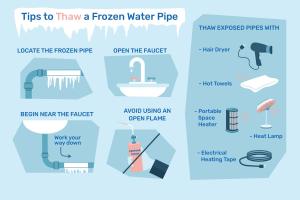Essential Guide: How to Thaw a Frozen Pipe Safely and Effectively

-
Quick Links:
- Introduction
- Understanding Frozen Pipes
- Warning Signs of Frozen Pipes
- Prevention Methods for Frozen Pipes
- Thawing Methods for Frozen Pipes
- Case Studies and Real-World Examples
- Expert Insights
- Step-by-Step Guide to Thawing a Frozen Pipe
- FAQs
Introduction
Frozen pipes can be a homeowner's nightmare, often leading to significant damage and costly repairs. This comprehensive guide will provide you with everything you need to know about thawing frozen pipes, from understanding why they freeze to effective thawing techniques.
Understanding Frozen Pipes
Pipes can freeze when the temperature drops significantly, causing water inside to expand and potentially rupture the pipe. Understanding the mechanisms of freezing pipes is essential to prevent this issue and respond effectively when it occurs.
Factors Leading to Frozen Pipes
- Temperature: Water inside the pipe freezes at 32°F (0°C).
- Poor Insulation: Pipes in unconditioned areas like attics or basements are more prone to freezing.
- Rapid Temperature Drops: Sudden cold snaps can catch homeowners off guard.
Warning Signs of Frozen Pipes
Identifying frozen pipes early can save you from extensive damage. Look for these warning signs:
- Unusual drops in water pressure.
- Frost on exposed pipes.
- No water flow from faucets.
Prevention Methods for Frozen Pipes
Preventing frozen pipes is the best strategy. Here are some effective methods:
- Insulate Pipes: Use foam insulation or pipe sleeves.
- Keep the Heat On: Maintain a consistent temperature in your home.
- Open Cabinet Doors: Allow warm air to circulate around plumbing fixtures.
Thawing Methods for Frozen Pipes
If you suspect a pipe is frozen, it's crucial to act quickly. Here are several effective thawing methods:
1. Heat Tape
Heat tape can be wrapped around the frozen section of the pipe to safely thaw it. Follow the manufacturer's instructions for application.
2. Hair Dryer
A hair dryer can be used to apply gentle heat to the frozen section. Start at the faucet end and work your way back.
3. Space Heater
Position a space heater near the frozen pipe while ensuring it is safe and monitored to prevent fire hazards.
4. Warm Towels
Soaking towels in hot water and wrapping them around the pipe can also help thaw the ice.
Case Studies and Real-World Examples
In the winter of 2021, a family in Minnesota faced severe damage due to frozen pipes. They neglected to insulate their basement pipes, resulting in a burst pipe that caused flooding. This incident underscores the importance of prevention.
Expert Insights
Plumbing experts advise homeowners to prioritize pipe insulation and regularly check vulnerable areas during cold months. They recommend keeping a small trickle of water flowing during extreme cold to prevent freezing.
Step-by-Step Guide to Thawing a Frozen Pipe
Follow this detailed guide to safely thaw a frozen pipe:
- Identify the frozen section of the pipe.
- Turn on the faucet to relieve pressure and allow water to flow once thawed.
- Apply your chosen thawing method (heat tape, hair dryer, etc.).
- Monitor the pipe closely until water flow resumes.
- If the pipe does not thaw, consider calling a professional plumber.
FAQs
1. How can I tell if my pipes are frozen?
Look for frost on the pipes or a sudden drop in water pressure.
2. What should I do if a pipe bursts?
Shut off the main water supply and call a plumber immediately.
3. Can I use a blowtorch to thaw a frozen pipe?
No, using an open flame can damage the pipe and pose a fire hazard.
4. How can I prevent my pipes from freezing?
Insulate pipes and keep your home heated during cold weather.
5. What temperature causes pipes to freeze?
Pipes can freeze when temperatures drop below 32°F (0°C).
6. Is it safe to leave a faucet dripping to prevent freezing?
Yes, a small trickle can help prevent pipes from freezing.
7. Can frozen pipes cause water leaks?
Yes, if the ice expands too much, it can lead to cracks and leaks.
8. How long does it take for a frozen pipe to thaw?
It can take several minutes to a few hours, depending on the thawing method used.
9. Should I call a plumber for frozen pipes?
If you're unsure or the situation seems severe, it's best to consult a professional.
10. What materials can I use to insulate my pipes?
Foam insulation, pipe sleeves, and heat tape are effective options.
Random Reads
- How to reduce video size
- How to reduce twitch stream delay
- How to mix gold color paint
- How to mine in minecraft
- How to start a gang in gta san andreas
- How to protect windows from a hurricane
- How to rotate youtube video
- How to use a calling card
- Mastering tricks mario kart wii
- How to repair woodpecker holes in cedar siding